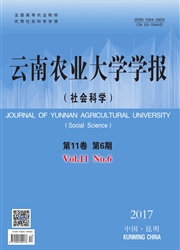

 中文摘要:
中文摘要:
云南烟草丛顶病是由烟草丛顶病毒(TBTV)、烟草扭脉病毒(TvDV)、烟草丛顶病毒类似卫星RNA(sat—TBTV)以及烟草扭脉病毒相关RNA(TVDVaRNA)复合侵染引起的一种危险性烟草病害。利用带毒烟蚜(Myzus persicae)对12种植物进行蚜虫传毒接种试验,传毒时间为15d。结果发现:接种的辣椒、酸浆等茄科植物表现褪绿、黄化和皱缩等症状,而黄瓜、菜豆等非茄科植物未表现明显症状。利用RT·PCR技术检测接种植物中云南烟草丛顶病病原物的种类,发现酸浆、假酸浆、曼陀罗、番茄、矮牵牛和辣椒6种茄科作物均能感染云南烟草丛顶病中的4种病原物,而黄瓜、西葫芦、昆诺藜、豇豆、菜豆和油菜等6种植物只能感染云南烟草丛顶病中的部分病原物。其中,烟草扭脉病毒(TVDV)的检出率最高,为83.3%,表明TVDV在病害的发生及流行中起了重要作用,通过蚜虫传毒方式可以将云南烟草丛顶病中的部分病原物分开,有利于研究不同病原物在症状的形成及流行中的作用,同时为其他多种病毒复合侵染引起植物病害的研究提供参考。
 英文摘要:
英文摘要:
Tobacco bushy top bacco bushy top virus ( TBTV ) disease (TBTD) is a complex disease caused by mixed infection of To- Tobacco vein distorting virus (TVDV), satellite RNA of TBTV ( Sat- TBTV) and/or Tobacco vein distorting virus associate RNA (TVDVaRNA). Twelve plant species were used to test the host range of TBTD pathogens by viruliferous aphid transmission for 15 days. The inoculated Solanaeeae spp. plants such as Capsicum annuum and Physalis chlorosis, yellowing and shrinking on the leavies, however, no distinct symptom was observed on the inoculated plants such as Cucumis sativus and Phaseolus vulgaris. The TBTD pathogens were then tested by RT- PCR and results showed that six Solanaceae spp. plants including P alkekengi Datura stramonium, Lycopersicon esculentum, Petunia hybrida and C. annuum , Nicandra physaloides, could be infected by all of the four TBTD pathogens. However, only one to three TBTD pathogens could infect the other tested plants such as C. sativus, Cucurbita pepo, Chenopodium quinoa, Vigna unguiculata, P. vulgaris and Brassica campestris. TVDV could be detected with the highest ratio of 83.3 %, suggesting that TVDV plays very important roles in disease cycle. The results also indicated that some of the TBTD pathogens could be separated from some tested host plants with the aphid transmission way, it would be beneficial to studying the functions of different TBTD pathogens in disease symptoms formation and disease trans- mission. The results also offer some valuable information for the studies on other complex plant disease co-infected by different virus pathogens.
 同期刊论文项目
同期刊论文项目
 同项目期刊论文
同项目期刊论文
 期刊信息
期刊信息
